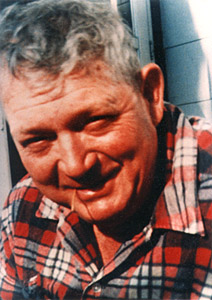
Frank L. Wurzelbacher
December 27, 1914 - December 22, 1986
|
Brother Tom says he had a cow named Mabel, but very few had names. Dad identified the milking cows in other ways, usually by disposition. All cows were dehorned as calves and the kickers had metal restraints on their legs during milking hours; otherwise they upset the pails of valuable milk. In summer the cows strolled with purpose to the pasture, ate their fill of grass, lay in the morning sun and contentedly chewed their cud in the shade of the ash and maple trees at high noon. Late in the afternoon they slowly meandered toward the big barn as Dad called the cows or we kids drove the black and white Holstein cows into their stanchions for milking. Every cow knew its stanchion; all we kids had to do was slam the stanchions shut.
Every day there was manure to be scraped into the gutters, wheelbarrows to be trudged out to the manure pile in winter, or in better weather into the spreader ready for the fields. On Sundays, card games were left unfinished and trips to the Cincinnati relatives shortened to arrive home in time for milking. On holidays, visiting city cousins helped, or thought they did.
Twice a day, can after can was filled and swung into the coolers for the milkman. Occasionally, everyone stood guard when the milk inspector was in the area. We used no masks or goggles or latex gloves when we cleaned corners, swept walls and webs — we were just farm kids doing as they were told. A “yuck” job as my sister Joan often groaned. Mom was always eager when the milk check arrived. Although payments based on Grade A milk varied by season and market, they supported much living and 119 years of Catholic education for me and my nine siblings.
Oh, the loft. Huge barn doors with Dutch doubles on blacksmith hinges with one side divided further into a man-sized door to walk through. The bays right and left of the center drive were stacked high with bales of hay, solid and heavy, mostly alfalfa and some mixed with clover. Bales of wheat and oat straw for bedding filled the far corner. Climb up and throw those scratchy rectangles down. Lift the trap door with its hand sized metal ring. How many each day? How many per cow during its lifetime?
Cathedral-like wood beams contrasted with quarter-sized spiders webbed into every joist, back lighted by sunshine, dust, and dancing motes. Dark corners and nests of burlap sacks offered hiding places for kittens. Although Dad gave us hints and detailed locations, the mother cat was forever moving her young to avoid us.
Permanent, vertical ladders with far-spaced slats for rungs climbed both sides of the hay mows. Birds, mostly generations of sparrows, flittered back and forth from this heaven of shelter and food. As the winter dragged on, the bales gradually disappeared. In June the empty mow had to be replenished to the rafters with fresh bales of hay bound with new twine. Another season of fodder ready for a winter of digestion and conversion into milk.
Hay and straw bales were also for building forts, for games of hide and seek across lofts — ageless amusement for farm kids. The mow was a great place to temporarily avoid punishment and wait for forgiveness like when first grader Linda coaxed five-year-old Ellen to take monopoly money and walk to town for candy!
Sometimes a hay wagon or hay elevator was pulled through the big doors and stored in the loft. In summer the big doors were open top and bottom, and the hay elevator carried a train of hay and straw bales to the mow where my brothers grabbed them with hay hooks, lifted, and stacked them in the sweltering summer heat under the peak of the roof. In winter when harvest was complete and there was more leisure, the hay mow was sometimes a quiet and secure place for an adolescent to be alone with his or her thoughts and problems.
|

![]()
![]()

![]()
![]()